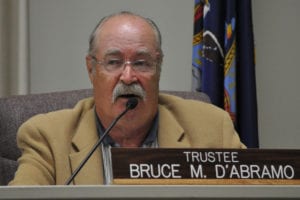The Legislature may not be behind them, but Suffolk County residents are still calling the red light camera program a money grab and a safety hazard.
People cried out in support of county Legislator Rob Trotta’s (R-Fort Salonga) bill to suspend the county’s program during a Public Safety Committee meeting on May 26, but the Suffolk legislative committee stopped it from coming to fruition. The vote was 5 to 3 against a motion to move the bill to the full county Legislature for voting after nearly 20 residents spoke up against the use of the cameras.
Stephen Ruth Jr., pleaded not guilty at his arraignment on June 3 to 17 counts of criminal mischief after allegedly tampering with 16 red light cameras at intersections along Route 25 in Coram. He also spoke at the Legislature meeting late last month.
“Red light cameras are a detriment to Suffolk County,” he said. “The risks and damages to the well-being of Suffolk County residents far outweigh the benefits. We all know now that red lights cameras are a systematic form of extortion and nothing more. … Traffic signals were manipulated for revenue and it was only made possible by Suffolk County’s reckless willingness to do anything for money.”

Residents cited statistics to try to back up their issues with the program, using a 42 percent increase in rear-end collisions in 2014 as evidence of the program’s shortcomings, and said nearly half of the locations where cameras were installed showed an increase in personal injury.
“You’re not here working for the middle class people, you’re actually hurting them,” Hector Gavilla said. “The program is not working at all. We were promised that these red light cameras would stop these incidents.”
But overall, crashes have decreased by 3.1 percent, while T-bone crashes have decreased by 21.6 percent. The data also reflects an overall decrease in crashes involved injury by 4.2 percent, based upon data from the New York State Department of Transportation’s most current data available as of December 2014.
Rachel Lugo, who has worked in highway safety for over 20 years, was the only person to speak in support of the cameras. She said that although crashes have increased, she believes it’s not because of the cameras, but as a result of more new drivers on the road, and “increasingly dangerous” issues like texting and being distracted while driving, drinking while driving and being under the influence of drugs.
“You can’t say that these crashes are increasing because of red light cameras,” she said. “What about stop signs? Let’s take them away also. Why won’t we just take away traffic lights? Red light cameras are not the problem. Teaching the motorists to change their behavior behind the wheel is where we need to start. If everyone stopped at the red lights we wouldn’t have to worry about what’s going on with fines and who is making money.”
There are statistics to back her up.
Paul Margiotta, executive director of Suffolk County’s Traffic and Parking Violations Agency, said that between 2012 and 2013, the county saw a 34,000 increase is licensed drivers, where prior to 2012 the average was trending down. He said citations for texting and driving and distracted driving doubled since 2011, which tends to cause rear-end crashes.
Legislature William “Doc” Spencer (D-Centerport) joined Leslie Kennedy (R-Nesconset) and Tom Cilmi (R-Bay Shore) in voting to pass the bill.
Spencer asked to put the program under a microscope.
“We have to do something,” he said. “It’s hard for me to discount the public outcry. There’s a lot of smoke here. I want to make sure I’m doing my oversight job to make sure I have looked at this with a very detailed eyed.”

County Legislator Kara Hahn (D-Setauket) agreed, although she stated that there was always an expectation that there would be an increase in rear-end crashes.
“Many things we deal with here are not black and white,” she said. “The policy decision was to institute an enforcement mechanism that will decrease the right-angle crashes which cause the more serious injuries and death, with the chance of and the expectation that there will be some uptick in rear-end crashes.”
She said she would like to see a report done on the intersections where there were a large number of rear-end crashes, to see if a majority of them were a result of the cameras, or other things like texting and driving.
According to William Hillman, Suffolk’s chief engineer, that investigation is ongoing. The county is in the process of reviewing crash data at the 42 intersections it controls. The state controls the other 58 intersections with cameras.
“These intersections where there’s been that high uptick, all-due haste is needed in reviewing what is going on so that we have a real answer,” Hahn said. “There’s a huge increase in crashes just in general because of distracted driving. This is happening more and more and red light cameras are not going to stop that. What red light cameras were designed to do was for the folks who were choosing to put their foot on the gas when the light turns yellow, to rethink that. They will actually stop at a red light, and that will save lives when people know that there could be consequences for running a red light. And that probably already has, because we’ve seen a decrease in T-bone crashes, which are more serious and life-threatening, and that is the purpose of the program.”






















